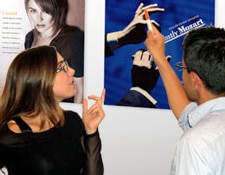
Design Career Guide
Portfolio Basics
Clients and employers evaluate you for jobs primarily on the basis of work you’ve accomplished. Building a strong portfolio is essential to launching your career as a designer. But how do you craft quality work when you’re still learning the ropes?
In this interview, our portfolio review team discusses some tips on how to start putting together an effective portfolio, even if you’re still in school.
WHAT IS THE GOAL OF A PORTFOLIO?
An effective portfolio accurately represents the designer’s abilities and skills in the best possible light. This means that it is clean and well put-together, and while it’s nice to try to be a little different, a portfolio should not look gimmicky. The viewer should be more aware of the work than the portfolio itself. An effective portfolio illustrates the designer’s self-presentation and communication abilities as well as showcasing the work.
WHAT IS A "PORTFOLIO PIECE?"
For a design student, the more in-depth the project, the more chance it has of becoming a good portfolio piece. A piece that clearly shows the ability to research a project and also exhibits skill with typography, color, composition, and technical issues will say a lot about the designer in a small space. A prospective employer will be going rapidly through your work, so it’s important to push your best work forward.
WHAT IS THE PORTFOLIO REVIEW PROCESS AT A TYPICAL ART SCHOOL?
At a traditional design school like Parsons School of Design, where some of us studied, students all bring their portfolios to the review, and one by one they lay them out on the table and have them torn to shreds! It’s really a hard-core critique. And the work that’s getting critiqued in a portfolio review may have been critiqued more gently at an earlier point in the year. But at the end of the program, when your portfolio is complete, it’s looked at with a harsher perspective—more like the fast appraisal it will be met with in the job market.
DO PEOPLE GET UPSET WHEN THEIR WORK GETS CRITIQUED?
Absolutely! People would burst into tears, run out of the room crying. You’d be high-strung and extra-vulnerable too, because you stay up all night for weeks trying to make your portfolio what you hope the teacher will want, working your butt off on pieces that get cut with a wave of the teacher’s hand. And you’re afraid some of your favorite pieces may be axed—which they often are. In a portfolio review nothing is sacred, no matter how much love or effort you put in to a piece: if it works it stays; if it doesn’t, it goes.
HOW IMPORTANT IS GETTING A SECOND OPINION ABOUT YOUR WORK?
Getting a second opinion is super-helpful. It’s very difficult to self-edit, especially when you’re putting together your first portfolio. You may be really attached to a certain piece of work that just doesn’t fit in with the rest of your book. Without a second opinion, it’s difficult to see that.
WHAT'S DIFFERENT ABOUT A PORTFOLIO REVIEW AT AN ONLINE SCHOOL?
Well, for one thing, you are receiving your comments privately, as opposed to verbally in front of an entire class. At an online school, the emphasis is more clearly on each individual, as opposed to a class where there is a competitive vibe between students.
Students in our online review will find their work being reviewed by a more critical voice than they’ve heard in their Sessions classes up until that point. Classes can be challenging, but they’re supportive environments. In the portfolio review, we’re looking for unflinching, industry-honed impressions of the work from a professional portfolio standpoint.
HOW CAN DESIGNERS DEVELOP THE ABILITY TO BECOME MORE OBJECTIVE ABOUT THEIR OWN WORK?
Objectivity often comes from letting go. Remember, removing a piece in your portfolio is not equivalent to burning it! You don’t invalidate a work by editing it from the book you take on job interviews. Another way to become more objective is to spend time looking at other people’s work with a critical eye, thinking about what could have been done differently to improve the work. When you train your eye on the work of others you can do so without having your judgment clouded by the fact that it’s yours.
WHAT ARE SOME PORTFOLIO-BUILDING OPPORTUNITIES THAT STUDENTS OFTEN OVERLOOK?
Every time you have an assignment that is set up from a client’s perspective, where you are doing an industry-specific project, you have an opportunity to create a portfolio piece; it is not just an exercise to help you learn a certain software or technique. If you are asked to make revisions, you have the chance to perfect that piece for your portfolio, so it is best to really put the time in, not rush on to the next project.
HOW MUCH DOES THE PORTFOLIO PRESENTATION MATTER?
If the portfolio is clean and well presented, that speaks to the designer’s communication skills. Also very important is the designer’s ability to speak about and explain the concept behind each project. The portfolio tells the prospective employer that the designer understands the relationship between art and commerce.